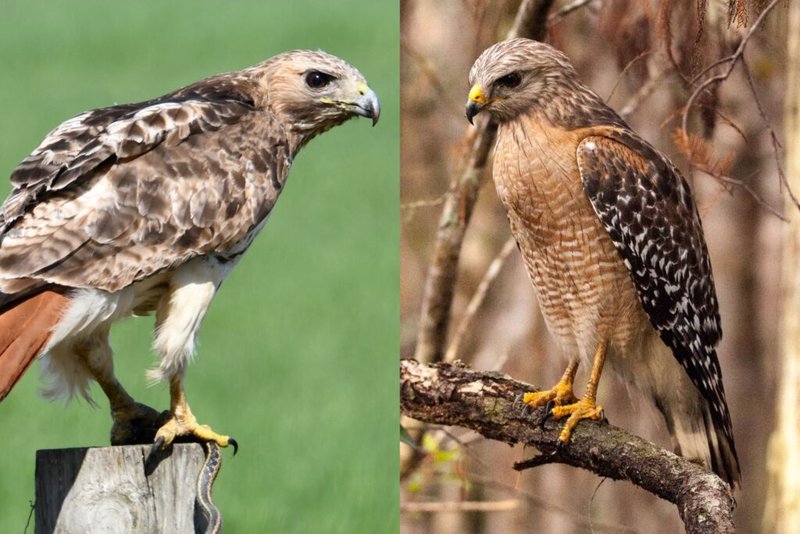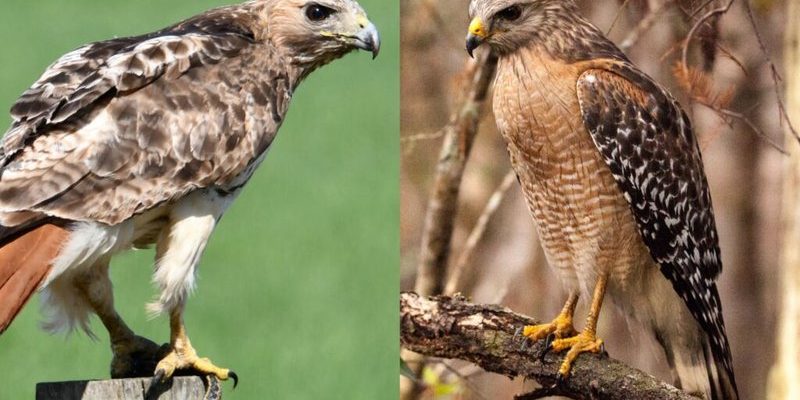
Let’s dive into what makes the red-tailed hawk stand out. It’s not just about its looks; differences in size, behavior, and habitat can really set it apart from its feathered friends. As we explore, think of this as unlocking a birdwatching cheat sheet, where knowing a few key details can transform your experience in the great outdoors.
What is a Red-Tailed Hawk?
The red-tailed hawk is a medium-to-large bird that belongs to the buteo family, known for its soaring flight and powerful build. Adult red-tailed hawks typically measure between 18 to 26 inches in length, with a wingspan that can reach up to 4.5 feet. The most striking feature, as mentioned, is its rusty red tail, which becomes more noticeable as the bird matures. These hawks boast a variety of plumage, ranging from dark brown to light sandy colors, making them adaptable to different environments.
You might be wondering where you can spot these magnificent birds. The red-tailed hawk is commonly found across North America, often perched on roadside poles or soaring effortlessly above open fields. Their adaptability to various habitats—from forests to deserts—makes them one of the most widespread raptor species in the continent. With their keen eyesight, they can spot prey from great distances, often swooping down to catch rodents, rabbits, and even small birds.
Similar Species: The Red-Shouldered Hawk
Another raptor you might encounter is the red-shouldered hawk. At first glance, the red-shouldered hawk can look a bit similar, but there are a few differences worth noting. This bird is generally smaller, ranging from 16 to 24 inches long, and has a striking, banded tail and vibrant red shoulders. While the red-tailed hawk’s tail is more of a uniform reddish hue, the red-shouldered hawk’s coloration is more complex, with patterns that can involve a mix of browns and whites.
You might spot the red-shouldered hawk in more wooded areas, often near rivers and swamps. Their call is quite distinct too—it has a loud, descending whistle that sounds somewhat like a “kree kree kree.” This vocalization can help you identify this bird even if you can’t see it.
Comparing Size and Shape
When you think of size, the red-tailed hawk tends to have a more robust build compared to the red-shouldered hawk. Here’s a quick comparison of their sizes:
| Species | Length (inches) | Wingspan (feet) |
| Red-Tailed Hawk | 18-26 | 3.3-4.5 |
| Red-Shouldered Hawk | 16-24 | 3.0-3.5 |
Both hawks have broad wings and a similar general shape, but the red-tailed hawk is noticeably larger and bulkier. If you find yourself observing a larger bird perched on a high branch, it’s likely the red-tailed hawk.
Differences in Coloration and Markings
The coloration of these birds can help you tell them apart as well. The red-tailed hawk typically has a mottled pattern of light and dark browns, giving it a somewhat camouflaged appearance. Its belly is often light with streaks of brown, while the back and wings are darker. The iconic red tail, especially when viewed from below, is a dead giveaway.
On the flip side, the red-shouldered hawk has a more striking pattern, with rich reddish-brown colors on the shoulders and intricate banding on its tail. Its breast is also banded, which adds to its visual appeal. If you find yourself comparing the two, focus on the tail and shoulder areas—these traits are like their fingerprints.
Hunting and Feeding Behaviors
When it comes to hunting, the red-tailed hawk employs a methodical approach. It often hunts by soaring high in the sky, scanning for movement below. Once it spots potential prey, it swoops down with incredible speed, using its powerful talons to catch its meal. This hawk typically prefers larger prey like rabbits and squirrels, which means it needs a good view of open land to spot them.
In contrast, the red-shouldered hawk tends to hunt in a different style. They are more likely to be seen hunting from a perch in a tree, rather than soaring overhead. Once they locate prey—often smaller animals like frogs and small birds—they dive down quickly from their perch. Their diet reflects their habitat preferences, focusing on animals that are abundant in wooded areas.
Vocalizations: How They Communicate
Bird calls can be a fascinating way to differentiate between species, and both the red-tailed and red-shouldered hawks have distinct sounds. The red-tailed hawk’s call is a sharp, three-part scream that has become somewhat iconic. It’s often used in movies and TV shows when a scene involves nature, adding drama and excitement.
On the other hand, the red-shouldered hawk has a more unique, descending whistle. This call can sometimes sound like it’s saying “kee-kee-kee.” If you hear a series of these calls echoing through the trees, you might have stumbled upon a red-shouldered hawk.
Habitat Preferences
While both species can adapt to various environments, their habitat preferences can vary. The red-tailed hawk can thrive in open areas such as grasslands, fields, and even urban environments. You’re likely to see them perched on telephone poles or gliding above highways.
Conversely, red-shouldered hawks prefer more forested areas. They often nest near water bodies like rivers and swamps. Their need for trees makes them less common in urbanized regions compared to their red-tailed cousins. When you’re out birdwatching, take note of the surroundings—a quick glance at the habitat can often lead you to the right hawk!
So, there you have it! Understanding the differences between the red-tailed hawk and similar species, like the red-shouldered hawk, can enhance your birdwatching experiences. From their striking appearances to their unique hunting styles, each bird plays a vital role in the ecosystem. The next time you spot a hawk soaring above, you’ll be better equipped to identify which one it might be.
Keep your binoculars handy and enjoy the simple joy of observing these magnificent birds in the wild! And remember, your ability to spot the subtle differences will not only deepen your appreciation for these creatures but might also inspire others to take an interest in the fascinating world of birds. Happy birdwatching!

